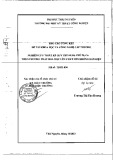
BioMed Central
Page 1 of 5
(page number not for citation purposes)
Virology Journal
Open Access
Short report
Increased production of viral proteins by a 3'-LTR-deleted infectious
clone of human T-cell leukemia virus type 1
Takeo Ohsugi
Address: Division of Microbiology and Genetics, Center for Animal Resources and Development, Institute of Resource Development and Analysis,
Kumamoto University, 2-2-1 Honjo, Kumamoto 860-0811, Japan
Email: Takeo Ohsugi - ohsugi@gpo.kumamoto-u.ac.jp
Abstract
We previously reported that a full-length provirus of HTLV-1 was directly constructed from the
HTLV-1-transformed cell line MT-2 using overlapping polymerase chain reaction (PCR) and cloned
into a plasmid vector (pFL-MT2). 293T cells transfected with pFL-MT2 alone did not produce virus
particles because there was no expression of the viral transactivator protein Tax, whereas cells
transfected with pFL-MT2 plus a Tax expression vector produced virus-like particles. In the
process of constructing the HTLV-1 provirus by overlapping PCR, we also constructed an
incomplete molecular clone, in which the 3' long terminal repeat (LTR) was replaced with the
endogenous human gene, which resulted in the expression of a tax gene shorter by 43 bp. This
incomplete molecular clone alone expressed Tax and produced the viral protein in transfected
cells. Various clones were then constructed with different lengths of the 3' LTR and lacking the
reverse-direction TATA box. The clones contained over 113 bp of the 3' LTR, with no reverse-
direction TATA box, which might express the full-length tax gene, and did not produce the viral
antigen. These results suggest that Tax in which the C-terminal portion is deleted is more strongly
expressed than the wild-type protein and has transcriptional activity.
Findings
Human T-cell leukemia virus type 1 (HTLV-1) was the first
human retrovirus to be isolated [1,2]. It causes an aggres-
sive malignancy known as adult T-cell leukemia/lym-
phoma, as well as inflammatory diseases such as HTLV-1-
associated myelopathy/tropical spastic paraparesis, after a
very prolonged period of latency, often lasting between 20
and 50 years [3,4]. The tax gene product encoded by the
pX region of HTLV-1 appears to be a key element in the
development of HTLV-1-associated diseases [5-7]. Tax
enhances productive virus replication by driving gene
transcription via the cAMP-responsive element located in
the viral long terminal repeat (LTR) [8,9]. Tax also acti-
vates the expression of many cellular genes, including
genes that encode cytokines, cytokine receptors, and
immediate early transcription factors, via the activation of
several cellular signal transduction pathways, such as the
nuclear factor kappaB (NF-κB) and serum response factor
(SRF) pathways [10-12].
The generation of infectious viruses from cloned proviral
DNA is one of the best ways to investigate the biology and
pathogenicity of viruses, and to improve methods of dis-
ease control. We previously constructed an infectious
molecular clone using overlapping polymerase chain
reaction (PCR) [13]. 293T cells transfected with this clone
alone did not produce virus-like particles, whereas cells
transfected with this clone plus a Tax expression vector
produced viral-like particles. These cells were then used to
produce virus-like particles that were capable of infecting
Published: 24 December 2009
Virology Journal 2009, 6:229 doi:10.1186/1743-422X-6-229
Received: 23 October 2009
Accepted: 24 December 2009
This article is available from: http://www.virologyj.com/content/6/1/229
© 2009 Ohsugi; licensee BioMed Central Ltd.
This is an Open Access article distributed under the terms of the Creative Commons Attribution License (http://creativecommons.org/licenses/by/2.0),
which permits unrestricted use, distribution, and reproduction in any medium, provided the original work is properly cited.






























